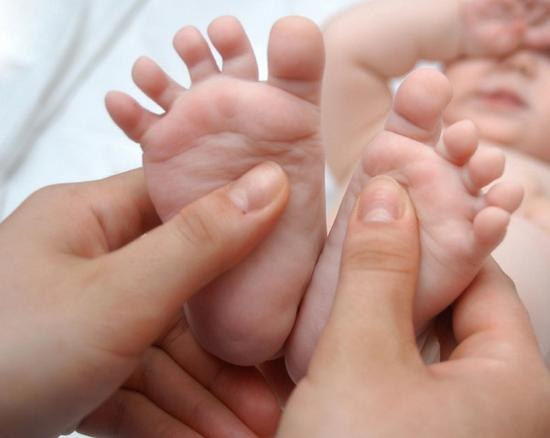At the age of one year most children already have to walk. It was during this period revealed all kinds of orthopedic issues, including clubfoot" - the habit of putting the foot when walking toe inside. The child may not be able to put both legs or just one, but in any case he needs to see an orthopedic surgeon and osteopath.
Some parents do not pay attention clubfoot, considering that baby's just easier to move that way, and over time he learns to walk properly. Happens sometimes, but more often clubfoot is indicative of a health problems.
There are several most common causes of viral installation of the foot (doctors call this problem). In the first place is the hypertonicity of the muscles, when the muscles are always more intense as compared to others. When unilateral hypertonicity child wryly puts one leg and walking forward exposes one shoulder.
The cause of clubfoot may be hip dysplasia is not detected at an early age. While underdeveloped the joint gets stiff and the child when walking forced to turn socks inside to facilitate movement.
Another possible cause is a slight degree of rickets, in which slightly distorted the tibia, and the child simply cannot put a foot right.
To establish the cause of clubfoot and prescribe treatment can only a doctor. When dysplasia and hypertonicity excellent results gives a foot massage, starting from the gluteal region and ending with the soles of their feet. Parents can consult a professional massage therapist or to perform massages for the child. With hypertonicity podiatrist often appoints kid coniferous-salt bath, swimming pool and special exercises to relieve tension in the muscles.
It is very important to follow the diet of the child. Problems with the musculoskeletal system often occur due to lack of calcium and phosphorus, therefore, of a kid's menu must be fish, cheese and other dairy products.
Should be chosen for baby shoes with a closed nose and tight high heel, which captures the good foot. Do not wear sandals and booties with soft soles or walking across the floor in socks. But to run in the warm season barefoot on pebbles or sand, is very good for strengthening the arch of the foot.
Some parents do not pay attention clubfoot, considering that baby's just easier to move that way, and over time he learns to walk properly. Happens sometimes, but more often clubfoot is indicative of a health problems.
Why year old child can clubfoot on one foot
There are several most common causes of viral installation of the foot (doctors call this problem). In the first place is the hypertonicity of the muscles, when the muscles are always more intense as compared to others. When unilateral hypertonicity child wryly puts one leg and walking forward exposes one shoulder.
The cause of clubfoot may be hip dysplasia is not detected at an early age. While underdeveloped the joint gets stiff and the child when walking forced to turn socks inside to facilitate movement.
Another possible cause is a slight degree of rickets, in which slightly distorted the tibia, and the child simply cannot put a foot right.
What to do if a child is pigeon-toed on one foot
To establish the cause of clubfoot and prescribe treatment can only a doctor. When dysplasia and hypertonicity excellent results gives a foot massage, starting from the gluteal region and ending with the soles of their feet. Parents can consult a professional massage therapist or to perform massages for the child. With hypertonicity podiatrist often appoints kid coniferous-salt bath, swimming pool and special exercises to relieve tension in the muscles.
It is very important to follow the diet of the child. Problems with the musculoskeletal system often occur due to lack of calcium and phosphorus, therefore, of a kid's menu must be fish, cheese and other dairy products.
Should be chosen for baby shoes with a closed nose and tight high heel, which captures the good foot. Do not wear sandals and booties with soft soles or walking across the floor in socks. But to run in the warm season barefoot on pebbles or sand, is very good for strengthening the arch of the foot.
